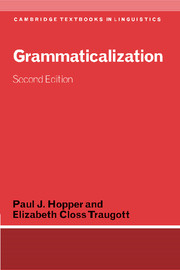Book contents
- Frontmatter
- Contents
- List of figures
- List of tables
- Preface and acknowledgments
- List of abbreviations
- 1 Some preliminaries
- 2 The history of grammaticalization
- 3 Mechanisms: reanalysis and analogy
- 4 Pragmatic factors
- 5 The hypothesis of unidirectionality
- 6 Clause-internal morphological changes
- 7 Grammaticalization across clauses
- 8 Grammaticalization in situations of extreme language contact
- 9 Summary and suggestions for further work
- Notes
- References
- Index of names
- Index of languages
- General index
8 - Grammaticalization in situations of extreme language contact
Published online by Cambridge University Press: 05 June 2012
- Frontmatter
- Contents
- List of figures
- List of tables
- Preface and acknowledgments
- List of abbreviations
- 1 Some preliminaries
- 2 The history of grammaticalization
- 3 Mechanisms: reanalysis and analogy
- 4 Pragmatic factors
- 5 The hypothesis of unidirectionality
- 6 Clause-internal morphological changes
- 7 Grammaticalization across clauses
- 8 Grammaticalization in situations of extreme language contact
- 9 Summary and suggestions for further work
- Notes
- References
- Index of names
- Index of languages
- General index
Summary
Introduction
Most of the work on grammaticalization that we have discussed so far was conducted within the framework of a relatively monogenetic view of change. This approach arose out of a tradition that started with comparative linguistics and persisted in the very largely different context of generative grammar. However different they have been, nevertheless both of these traditions have idealized homogeneity of language and of transmission, whereas in fact most actual situations involve contact, at the minimum with speakers of other dialects, whether social, regional, or stylistic (see Weinreich, Labov, and Herzog 1968; Thomason and Kaufman 1988 for landmark studies of the consequences of heterogeneity for an understanding of how language changes).
We turn in this chapter to the question whether studies of contact situations raise special issues regarding grammaticalization (see also Heine and Kuteva 2002). We ignore situations of contact that entail only partial external influence on subparts of a linguistic system. One such situation is that of “borrowing,” which often involves extensive incorporation of foreign elements in only one or two areas of the language, typically the lexicon, with minimal influence elsewhere. Ordinarily the kinds of items borrowed are independent words and morphemes (Weinreich 1953), although very occasionally morphological paradigms may be borrowed (Thomason and Kaufman 1988: 20 cite the unusual case of Mednyi Aleut, with Russian finite-verb morphology but with other largely Aleut grammar and vocabulary).
- Type
- Chapter
- Information
- Grammaticalization , pp. 212 - 230Publisher: Cambridge University PressPrint publication year: 2003

